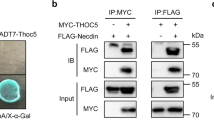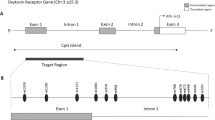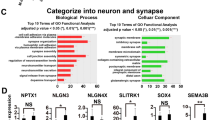Abstract
Prader-Willi syndrome (PWS) is a neurogenetic disorder resulting from the loss of paternal expression of gene(s) localized in the 15q11-q12 region. A new human gene encoding a putative protein with high homology to the mouse NECDIN protein has recently been characterized and mapped to chromosome 15q11-q12. It is expressed from the paternal allele only, suggesting its potential involvement in PWS. We now report the localization of the mouse Necdin gene in a region of conserved synteny to the human PWS region. We demonstrate the paternal specific expression of Necdin in the mouse central nervous system, and show that parental alleles display a differential methylation profile in the coding region. Finally, fluorescence in situ hybridization analysis reveals an asynchronous pattern of replication at the Necdin locus. These results clearly demonstrate imprinting of the mouse Necdin gene. Mouse models will be powerful tools in the study of human PWS phenotype and imprinting mechanisms.
Similar content being viewed by others
Log in or create a free account to read this content
Gain free access to this article, as well as selected content from this journal and more on nature.com
or
References
Maruyama K, Usami M, Aizawa T, Yoshikawa K: A novel brain-specific mRNA endocing nuclear protein (Necdin) expressed in neurally differentiated embryonal carcinoma cells. Biochem Biophys Res Commun 1991,178:291–296.
Uetsuki T, Tagaki K, Sugiura H, Yoshikawa K: Structure and expression of the mouse Necdin gene. J Biol Chem 1996;12:918–924.
Aizawa T, Maruyama K, Kondo H, Yoshikawa K: Expression of Necdin, an embryonal carcinoma-derived nuclear protein, in developing mouse brain. Dev Brain Res 1992,68:265–274.
Maruyama E: Biochemical characterization of mouse brain necdin. Biochem J 1996;314:895–901.
Hayashi Y, Matsuyama K, Tagaki K, Sugiura H, Yoshikawa K: Arrest of cell growth by necdin, a nuclear protein expressed in postmitotic neurons. Biochem Biophys Res Commun 1995;213:317–324.
Jay P, Rougeulle C, Massacrier P, et al: Human NECDIN is maternally imprinted and located in the Prader-Willi syndrome chromosomal region. Nat Genet, in press.
Nicholls RD, Knoll JHM, Butler MG, Karam S, Lalande M: Genetic imprinting suggested by maternal heterodisomy in non-deletion Prader-Willi syndrome. Nature 1989;342:281–285.
Butler MG, Palmer CG: Parental origin of chromosome 15 deletion in Prader-Willi syndrome. Lancet 1983;1:1285–1286.
Knoll JHM, Nicholls RD, Magenis RE, Graham JM, Lalande M, Latt SA: Angelman and Prader-Willi syndromes have a common chromosome 15 deletion but differ in parental origin of the deletion. Am J Med Genet 1989;32:285–290.
Sutcliffe JS, Nakao M, Christian S, et al: Deletions of a differentially methylated CpG island at the SNRPN gene define a putative imprinting control region. Nat Genet 1994;8:52–58.
Buiting K, Saitoh S, Gross S, et al: Inherited microdeletions in the Angelman and Prader-Willi syndromes define an imprinting centre on human chromosome 15. Nat Genet 1995;9:395–400.
Saitho S, Buiting K, Rogans P, et al: Minimal definition of the imprinting center and fixation of a chromosome 15q11-q13 epigenotype by imprinting mutations. Proc Natl Acad Sci USA 1996;93:7811–7815.
Dittrich B, Buiting K, Korn B, et al: Imprinting switching on human chromosome 15 may involve alternative transcripts of the SNRPN gene. Nat Genet 1996;14:163–170.
Jong M, Carey A, Stewart C, et al: The ZNF127 gene encodes a novel C3H4 zinc-finger protein and its expression is regulated by genomic imprinting. Am J Hum Genet 1993;53:697.
Ozcelik T, Leff S, Robinson W, et al: Small nuclear ribonucleoprotein polypeptide N (SNRPN), an expressed gene in the Prader-Willi syndrome critical region. Nat Genet 1992;2:260.
Wevrick R, Kerns J, Francke U: Identification of a novel paternally expressed gene in the Prader-Willi syndrome region. Hum Mol Genet 1994;3:1877–1882.
Buiting K, Dittrich B, Endele S, Horstemke B: Identification of novel exons 3′ to the human SNRPN gene. Genomics 1997;40:132–137.
Lalande M: Parental imprinting and human disease. Annu Rev Genet 1997;30:173–195.
Searle AG, Beechy CV: Genome imprinting phenomena on mouse chromosome 7. Genet Res 1990;56:237–244.
Beechy CV, Cattanach BM: Genetic and physical imprinting map of the mouse. Mouse Genome 1997;95:100–105.
Cattanach BC, Barr JA, Beechey CV, Martin J, Noebels J, Jones J: A candidate model for Angelman syndrome in the mouse. Mamm Genome 1997;8:472–478.
Cattanach BM, Barr JA, Evans EP, et al: A candidate mouse model for Prader-Willi syndrome which shows an absence of Snrpn expression. Nat Genet 1992;2:270–274.
Ausubel F, Brent R, Kingston R, et al: Current Protocols in Molecular Biology. New York, Wiley Interscience, 1987.
Laird PW, Zijderveld A, Linders K, Rudnicki A, Jaenish R, Berns A: Simplified mammalian DNA isolation procedure. Nucleic Acids Res 1991;19:4293–4295.
Chomcynszki P, Sacchi N: Single step method of RNA isolation by acid guanidinium thiocyanate-phenol-chloroform extraction. Anal Biochem 1987;162:156–159.
Pinkel D, Straume T, Gray JW: Cytogenetic analysis using quantitative, high sensitivity, fluorescence hybridization. Proc Natl Acad Sci USA 1986;83:2934–2938.
Matsuda Y, Harada YN, Natsuume-Sakai S, Lee K, Shiomi T, Chapman VM: Location of the mouse complement factor H gene (cfh) by FISH analysis and replication R-banding. Cytogenet Cell Genet 1992;61:282–285.
Lemieux N, Dutrillaux B, Viegas-Péquignot E: A simple method for simultaneous R- or G-banding and fluorescence in situ hybridization of small single-copy genes. Cytogenet Cell Genet 1992;59:311–312.
Selig S, Okumura K, Ward DC, Cedar H: Delineation of DNA replication time zones by fluorescence in situ hybridization. EMBO J 1992;11:1217–1225.
Chaillet JR, Knoll JHM, Horsthemke B, Lalande M: The syntenic relationship between the critical deletion region for the Prader-Willi/Angelman syndromes and proximal mouse chromosome 7. Genomics 1991;11:773–776.
Nicholls RD, Gottleib W, Avidano K, Williams CA, Driscoll D: Mouse chromosome mapping of clones from the PWS/AS genetic region. Mouse Genome 1991;89:254.
Nicholls RD, Gottleib W, Russel LB, Davda M, Horsthemke B, Rinchick EM: Evaluation of potential models for imprinted and nonimprinted components of human chromosome 15q11-q13 syndromes by fine-structure homology mapping in the mouse. Proc Natl Acad Sci USA 1993;90:2050–2054.
Hansen RS, Canfield TK, Gartier SM: Reverse replication timing for the XIST gene in human fibroblasts. Hum Mol Genet 1995;4:813–820.
Kitsberg D, Selig S, Brandeis M, et al: Allele specific replication timing of imprinted gene regions. Nature 1993;364:459–463.
Chess A, Simon I, Cedar H, Axel R: Allelic inactivation regulates olfactory receptor gene expression. Cell 1994;78:823–834.
De Chiara TM, Robertson EJ, Efstratiadis A: Parental imprinting of the mouse insulin-like growth factor II (Igf2) gene. Cell 1991;64:849–859.
Giddings SJ, King CD, Harman KW, Flood JF, Carnaghi LR: Allele-specific inactivation of insulin 1 and 2, in the mouse yolk sac indicates imprinting. Nat Genet 1994;6:310–313.
Villar AJ, Pederson RA: Parental imprinting of the Mas protooncogene in mouse. Nat Genet 1994;8:373–379.
Li E, Bestor TH, Jaenisch R: Targeted mutation of the DNA methyltransferase gene results in embryonic lethality. Cell 1992;69:915–926.
Razin A, Cedar H: DNA methylation and genomic imprinting. Cell 1994;77:473–476.
Jaenisch R: DNA methylation and imprinting: Why bother? Trends Genet 1997; 13:323–329.
Horsthemke B, Dittrich B, Buiting K: Parent-of-Origin-Specific DNA Methylation and Imprinting Mutations on Human Chromosome 15. Cambridge, Cambridge University Press, 1995, pp 295–308.
Barlow DP: Methylation and imprinting: From host defense to gene regulation? Science 1993;260:309–310.
Hansen RS, Canfield TK, Lamb MM, Gartler SM, Laird CD: Association of fragile X syndrome with delayed replication of the FMR1 gene. Cell 1993;73:1403–1409.
Knoll JHG, Cheng SD, Lalande M: Allele specificity of DNA replication timing in the Angelman/Prader-Willi syndrome imprinted chromosomal region. Nat Genet 1994;6:41–46.
Gunaratne PH, Nakao M, Ledbetter DH, Sutcliffe JS, Chinault AC: Tissue-specific and allele-specific replication timing control in the imprinted human Prader-Willy syndrome region. Genes Dev 1995;9:808–820.
Kawame H, Gartler S, Hansen S: Allele-specific replication timing in imprinted domains: Absence of asynchrony at several loci. Hum Mol Genet 1995;4:2287–2293.
White LM, Rogan PK, Nicholls RD, Wu BL, Korf B, Knoll JHM: Allele-specific replication of 15q11-q13 loci: A diagnostic test for detection of uniparental disomy. Am J Hum Genet 1996;59:423–430.
Bickmore WA, Carothers AD: Factors affecting the timing and imprinting of replication on a mammalian chromosome. J Cell Sci 1995;108:2801–2809.
Acknowledgments
We thank J.-L. Guenet for providing us WMP and M. spretus mice, and L. Dandolo and P. Isnard for the gifts of murine H19 and AF4 probes, respectively. This work was supported by grants from the Institut National de la Santé et de la Recherche Médicale (INSERM), the Fondation pour la Recherche Médicale (FRM), and the Association pour la Recherche sur le Cancer (ARC).
Author information
Authors and Affiliations
Corresponding author
Rights and permissions
About this article
Cite this article
Watrin, F., Roëckel, N., Lacroix, L. et al. The Mouse Necdin Gene Is Expressed from the Paternal Allele Only and Lies in the 7C Region of the Mouse Chromosome 7, a Region of Conserved Synteny to the Human Prader-Willi Syndrome Region. Eur J Hum Genet 5, 324–332 (1997). https://doi.org/10.1007/BF03405936
Received:
Revised:
Accepted:
Issue date:
DOI: https://doi.org/10.1007/BF03405936



